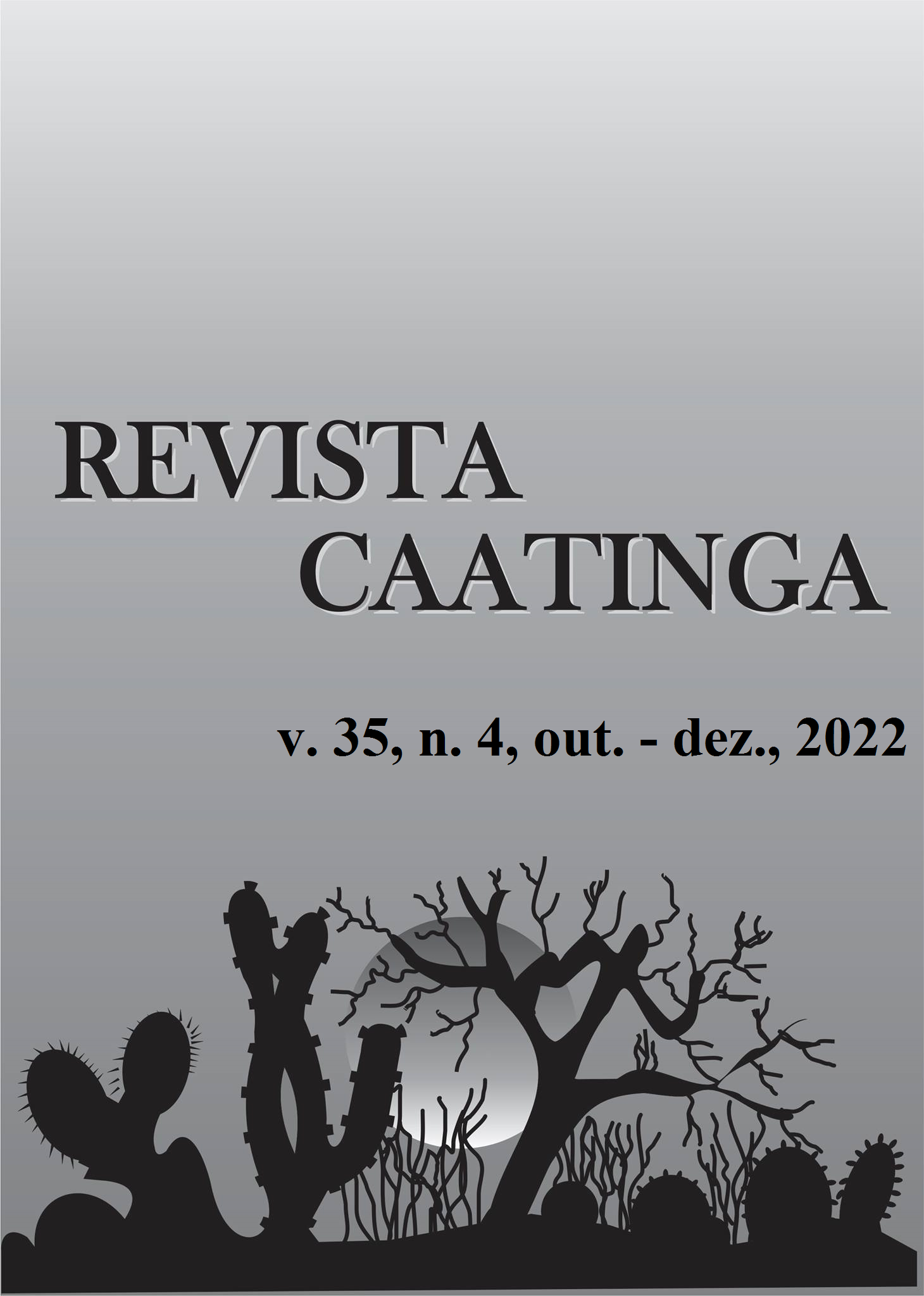SOURCES AND INHERITANCE OF LEAFMINER RESISTANCE IN YELLOW MELON ACCESSIONS
DOI:
https://doi.org/10.1590/1983-21252022v35n401rcKeywords:
Cucumis melo L.. Liriomyza spp.. Genetic resistance. Dominant gene.Abstract
The use of resistant cultivars is an efficient and recommended method for the management of leafminers, which are the main phytosanitary problem in melons. The objectives of this study were to identify the sources of resistance to the leafminer in yellow melon accessions and to determine the resistance inheritance in acession AM-RT. Two field experiments were conducted in the municipalities of Baraúna, RN and Icapuí, CE, Brazil, to identify the sources of resistance. The design adopted was completely randomized blocks with 22 treatments and four replications. In this evaluation, the number of mines per leaf was quantified. The heterogeneity of the studied materials allowed for the identification of the accessions AM-RT and AM-TM as sources of resistance, considering that they revealed zero mines in the two evaluation environments. The accession AM-RT was selected and used to obtain the S1 population (by self-fertilization), S1:2 population derived from S1, and crossing between AM-RT and ‘Goldex’, which were evaluated in a third laboratory trial to determine the genetic control of resistance in that material. By the segregation pattern of the populations S1, S1:2, and the crossing (AM-RT and ‘Goldex’) and the estimation of the chi-squared (χ2) values, which were 1.33, 3.14, and 0.36, respectively, it was determined that the inheritance of resistance was controlled by only one gene with complete dominance. Therefore, in this study, two sources of resistance to the leafminer were identified, and resistance was conditioned by a gene with complete dominance in the accession ‘AM-RT’.
Downloads
References
ARAUJO, E. L. et al. Biological aspects of the leafminer Liriomyza sativae (Diptera: Agromyzidae) on melon (Cucumis melo L.). Ciência Rural, 43: 579-582, 2013.
ASKARI-SARYAZDI, G. et al. Selection for chlorpyrifos resistance in Liriomyza sativae Blanchard: Cross-resistance patterns, stability and biochemical mechanisms. Pesticide Biochemistry and Physiology, 124: 86-92, 2015.
BASIJ, M. et al. Evaluation of resistance of cucumber cultivars to the vegetable leaf miner (Liriomyza sativae Blachard) (Diptera: Agromyzidae) in greenhouse. Chilean Journal of Agricultural Research, 71: 395-400, 2011.
CELIN, E. F. et al. New sources of resistance to leafminers (Liriomyza sativae) in melon (Cucumis melo L.) germplasm. Genetics and Molecular Research, 16: 1-12, 2017a.
CELIN, E. F. et al. Simple genetic inheritance conditions resistance to Liriomyza sativae in melon. Euphytica, 213: 1-11, 2017b.
COSTA, E. M. et al. Determination of damaged leaf area and physiological responses of melon plants submitted to different infestation levels of Liriomyza sativae. Horticultura Brasileira, 35: 571-575, 2017.
DHILLON, M. K.; SHARMA, H. C. Paradigm shifts in research on host plant resistance to insect pests. Indian Journal of Plant Protection, 40: 1-11, 2012.
DOGIMONT, C.; SARI, N. Gene list for melon. Curcubit Genetics Cooperative Report, 45: 1-47, 2022.
DOGIMONT, C. et al. One dominant gene conferring the resistance to the leafminer, Liriomyza trifolii (Burgess) Diptera: Agromyzidae in melon (Cucumis melo L.). Euphytica, 105: 63-67, 1999.
DOGIMONT, C. et al. Characterization of resistance to Liriomyza trifolli (Burgess) in melon (Cucumis melo). Fruits, 50: 449-452, 1995.
FERREIRA, E. C. B. et al. Molecular identification of Liriomyza sp. in the Northeast and Southeast regions of Brazil. Revista Caatinga, 30: 892-900, 2017.
GUIMARÃES, J. A. et al. Avaliação de Resistência de Híbridos de Melão Amarelo à Mosca Minadora Liriomyza spp. 1. ed. Brasília, DF: Embrapa Hortaliças, 2009. 16 p. (Boletim de Pesquisa e Desenvolvimento 54)
KENNEDY, G. G. et al. Leaf resistance in muskmelon. American Society for Horticutural Science, 103: 571-574, 1978.
LEIBEE, G. L. Insecticidal control of Liriomyza spp. on vegetables. In: PROCEEDINGS OF THE INSTITUTE OF FOOD AND AGRICULTURAL SCIENCES INDUSTRY CONFERENCE ON BIOLOGY AND CONTROL OF LIRIOMYZA LEAFMINERS, 1981, Florida. Proceedings... Gainesville: University of Florida, 1981. v. 2, p. 216-220.
LEITÃO, R. L. G. Herança genética e associação de marcadores microssatélites à resistência à Liriomyza sativae em meloeiro. 2018. 104f. Dissertação (Mestrado em Fitotecnia: Área de concentração Melhoramento Genético de Plantas) – Universidade Federal do Ceará, UFC, Fortaleza, 2018.
LIMA, A. C. C. et al. Diagnóstico sobre o uso do MIP nas principais áreas produtoras de melão dos Estados do Rio Grande do Norte e Ceará. Revista Agro@mbiente On-line, 6: 172-178, 2012.
NUNES, G. H. S. et al. Resistência de acessos de meloeiro à mosca-minadora Liriomyza spp. (Diptera: Agromyzidae). Revista Brasileira de Fruticultura, 35: 746-754, 2013.
R CORE TEAM. A language and environment for statistical computing. R Foundation for Statistical Computing, Vienna, R Foundation for Statistical Computing. 2018. Available in: <http://www.R-project.org/>. Acesso em: 15 jan. 2022
WEI, Q. B. et al. Abamectin resistance in strains of vegetable leafminer, Liriomyza sativae (Diptera: Agromyzidae) is linked to elevated glutathione S-transferase activity. Insect Science, 22: 243–250, 2015.
GIRÃO FILHO, J. E. et al. Resistência genética de acessos de feijão-fava ao gorgulho Zabrotes subfasciatus (Boh.) (Coleoptera: Bruchidae). Comunicata Scientiae, 3: 84-89, 2012.
TRAPERO, C. et al. Enhancing Integrated Pest Management in GM Cotton Systems Using Host Plant Resistance. Frontiers in Plant Science, 7: 1-12, 2016.
Downloads
Published
Issue
Section
License
Os Autores que publicam na Revista Caatinga concordam com os seguintes termos:
a) Os Autores mantêm os direitos autorais e concedem à revista o direito de primeira publicação, com o trabalho simultaneamente licenciado sob a Licença Creative Commons do tipo atribuição CC-BY, para todo o conteúdo do periódico, exceto onde estiver identificado, que permite o compartilhamento do trabalho com reconhecimento da autoria e publicação inicial nesta revista, sem fins comerciais.
b) Os Autores têm autorização para distribuição não-exclusiva da versão do trabalho publicada nesta revista (ex.: publicar em repositório institucional ou como capítulo de livro), com reconhecimento de autoria e publicação inicial nesta revista.
c) Os Autores têm permissão e são estimulados a publicar e distribuir seu trabalho online (ex.: em repositórios institucionais ou na sua página pessoal) a qualquer ponto antes ou durante o processo editorial, já que isso pode gerar alterações produtivas, bem como aumentar o impacto e a citação do trabalho publicado (Veja O Efeito do Acesso Livre).







